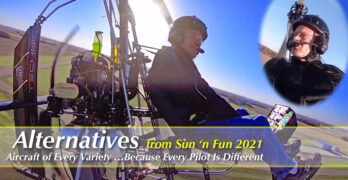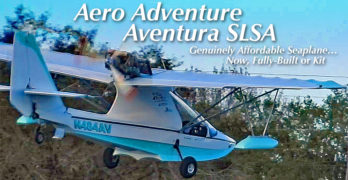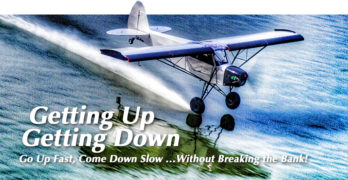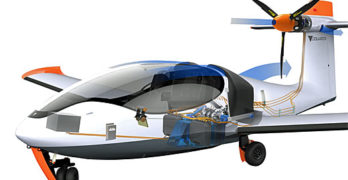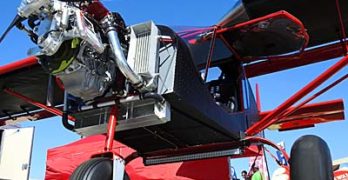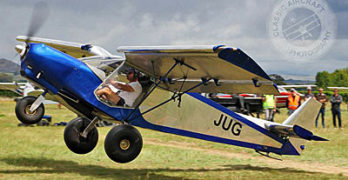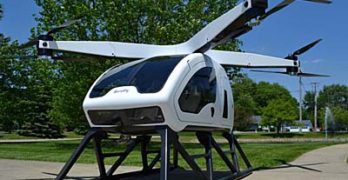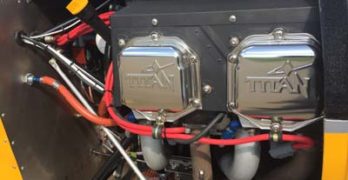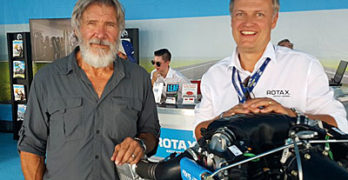We continue with further coverage from the first major airshow in almost two years… THANKS to Sun ‘n Fun 2021 for helping present these interesting aircraft and more.
This article has news …about two aircraft in a category I refer to as “alternative aircraft” …about an easily-mounted autopilot you can actually afford …and the success story of a French prop maker now well established in the USA.
Alternative aircraft is my umbrella term for weight shift aircraft (trikes), powered parachutes, gyroplanes, carriage-equipped powered paragliders (not the same as powered parachutes), Light-Sport motorgliders, and Light-Sport Lighter-than-Air flying machines. These unorthodox, not-mainstream aircraft have maintained a steady share of sales; around 100 new such aircraft enter the U.S. market every year.
Counting all types, the “alternative aircraft” sector may account for a quarter or more of all LSA sales. Alternative aircraft have attributes that drive customer inquiries: better affordability and unique flying qualities.
Search Results for : Viking engine
Not finding exactly what you expected? Try our advanced search option.
Select a manufacturer to go straight to all our content about that manufacturer.
Select an aircraft model to go straight to all our content about that model.
Ready for Sun ‘n Fun 2021 — Welcome the Newest SLSA: Affordable Aventura Amphibian
Affordable is a word I often hear as I explore the ever-expanding world of light aircraft. From Part 103 ultralights to kit-built aircraft you can fly with a Sport Pilot license (“Sport Pilot kit”) to fully-built, FAA-accepted Special Light-Sport Aircraft… the number of choices you have is dazzling.
UPDATE 4/3/21: A new video featuring an interview with Aero Adventure’s Alex Rolinski now appears at the bottom of this article. —DJ
Some of these numerous choices may run way past your budget, although a growing number of pilots are learning they can share ownership in one of various ways. Doing so can help you afford what you want yet many pilots enjoy the idea of owning their very own, highly-personal flying machine.
Those who want sole ownership of a seaplane will have to dig deeper into their pocket, sometimes much more deeply. Sadly, for many pilots this eliminates a chance to own a LSA seaplane all by yourself.
What’s Enough Power? Always More? Maybe Not, as Bill Canino Explains Zlin’s Shock Ultra
In the last couple months as we’ve all been struggling under the lockdowns happening across the country (and around the world), some of our best-read articles have been about going fast using the most powerful engines.
What pilot doesn’t want more power? Or speed?
The trouble with more power allowing more speed is that old auto racing line: “Speed costs money! How fast do you want to go?”
How about a not-so-expensive option?
U.S. importer Sportair USA has you covered.
Ultra Shock
If a name has “ultra” in it, the name implies the most of what you should want, right? Wrong! In this case, as famous architect Mies van der Rohe noted, “Less is More.”
It seems all the talk is about Rotax‘s 915iS or Titan’s X340, or most recently Continental‘s CD-170. All these engines share at least two things: (1) They are awesomely powerful, and (2) they might bust your budget.
Equator Light-Sport Aircraft Seaplane Secures Crowd Funding; Makes First Flight
This article has been updated with a new image; a minor correction was made.
LSA seaplanes have provided some of the most interesting new developments in aviation. Perhaps interest stems from the vast numbers of landable waterways compared to runways. Perhaps it’s the versatility of amphibians. Maybe people are simple drawn by the good looks or unique qualities of entries.
Among the several projects, one of the most fascinating has been the hybrid electric seaplane called Equator P2 Xcursion, from Norway. I have reported on P2 Xcursion before; here’s the earlier article.
Years in the Making
CEO and lead designer Tomas Brødreskift reports the company has invested some 30,000 man-hours into the Equator Aircraft project. An engineer, private pilot, and recreational flying enthusiast, he acquired a passion for flying that most readers know well. Like many of them, he saw in the aircraft he was flying a lack of modern design.
Sun ‘n Fun Day 3: STOLs Will Fly Florida to Alaska (Does that Read Oddly?)
On a single day of recording several videos at Sun ‘n Fun 2018, Videoman Dave and I came across two light kit aircraft designs operating as STOL — Short Take Off and Landing — aircraft. By itself that is hardly unusual. STOL designs are plentiful and popular.
However, when you hear that two STOL-focused airplanes will be flying from Florida to Alaska, that’s something else entirely. Flying from one corner of a big country to its diagonal opposite is a fairly significant undertaking. Depending on routes chosen, this is well beyond a 4,000-mile flight. Let’s see — at 80-90 mph an hour …well, suffice it to say, that’s a lot of flying, 40+ hours, each way, would not surprise me.
Viking 180 Horse on Zenith Super Duty
At Sebring 2018 Zenith Aircraft showed their Super Duty version of their CH750 high wing, a STOL airplane equipped with a large engine and tires to match.
Jumping Off the Ground F-A-S-T and Landing Super Short — Fun!
Sebastien Heintz of Zenith Aircraft in Mexico, Missouri is one of the more vigorous promoters in light aviation. He and his 25-year-old company are all over social media and advertise in big magazines. This week his news came from about as far away as possible, from way down under in New Zealand.
“A Zenith STOL, expertly piloted by Deane Philip, was the winner of the New Zealand Bush Pilot Championships in Omaka, New Zealand, on Saturday, February 3, 2017,” reported Sebastien. Deane won with a take-off distance of just 12.6 meters (41.3 feet) and a landing roll of 14.7 meters (48.2 feet). See the video below.
By any measure, that is very, very short.
“Another Zenith STOL aircraft, piloted by Chris Anderson, took second place,” bragged Sebastien. In third place was a Rans S6 for third place in the Sport Pilot (under 1,325 pound) category.
Deane’s STOL CH 701 is powered by a 130-horsepower Viking engine.
Your “Light-Sport” Quad Awaits, and It’s Affordable (kinda, sorta)
Update: Unknown at the time this article was posted, Viking Aircraft Engines reports it provides the powerplant for SureFly. —DJ July 5, 2017
News from the Paris Air Show probably does not interest you too much, unless you care about the airliner you will fly in eight years from now. However, one article caught my interest because of a few references. (The article I found is available here.)
Here’s the parts that grabbed me:
(1) “We’re hoping it can be a light-sport aircraft type of licence,” said developing company CEO Steve Burns. “We want to keep it minimal, and we believe it’s easy enough to fly to do that.”
(2) It will be pilot-operated; controls are said to be minimal, with buttons for up/down altitude adjustment, and a joystick for forward, sideways and yaw.
(3) The company aims to bring the SureFly to market at a price of just $200,000.
Happy 12th Birthday, Light-Sport Aircraft!
Earlier this month, Light-Sport Aircraft celebrated a birthday. The date was September 1st, when FAA made the then-new Sport Pilot/Light-Sport Aircraft rule “effective” (to employ FAA-speak). So… happy birthday, LSA.
In those dozen years — the newest aircraft segment is not even a teenager yet — quite a bit has changed. If you are a parent, you may not notice your child getting older as you see them daily. However, the distant uncle or grandparent who only gets to visit infrequently may be astounded how much the little guy or gal has grown. I suspect those close to LSA may have a similar perspective deficit, so let me make some contrasts.
The nearby images are from a talk I gave at the recently concluded Mid-West LSA Expo. I went into more detail than this article permits but I’ll bet you get the points.
AIRFRAMES — Today, we accept that we have some marvelous, sleek, high-tech, well-equipped, well-performing models.
Continental Motors Absorbs Titan X-340 Production
Coming up in just over two weeks! — September 8-9-10, 2016 — is the Midwest LSA Expo. I hope your plans include going. Plenty of aircraft are available and taking a demo flight is no easier anywhere. I will look for you on site! More info: Midwest LSA Expo.
Engines have changed a lot over the life of Light-Sport Aircraft. FAA’s new regulation became effective in September 2004. A hard working industry has brought 140 Special LSA models to market …in less than 12 years, one per month for every month (on average) since the rule emerged.
Engines have been similarly prolific.
In the beginning, Rotax‘s 65-horsepower two-stroke 582 was a often selected to power the lighter aircraft of the pre-LSA period. The 9-series engines had gained acceptance much earlier but as LSA got bigger and heavier, their success gave a tremendous push to the popular Austrian engine and it dominates to this day.
Latest and Greatest LSA from Oshkosh 2016
In a show as vast at EAA’s AirVenture Oshkosh, it is presumptuous to attempt covering everything of interest. What follows are some new aircraft I found in the categories I cover on this website. Other projects were certainly worthy of special note but with the goal of a fast dash through the latest and greatest, I’m keeping this one fairly lean. I’ll cover other developments in subsequent articles.
So, here’s three aircraft you haven’t seen before AirVenture 2016 plus a revised project involving an increasingly popular engine. I’ll start off with a famous guy checking out a famous engine to propel one of my favorite airplanes. We begin our quick review with Lockwood Aircraft‘s AirCam.
Of course, you know his face. When I once heard Harrison Ford speak, he said modestly (paraphrased), “I earn a living making faces.” I never thought of acting in such simple terms, but I accept such skills are part of the job.


